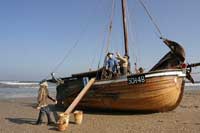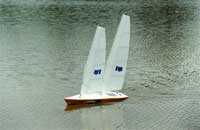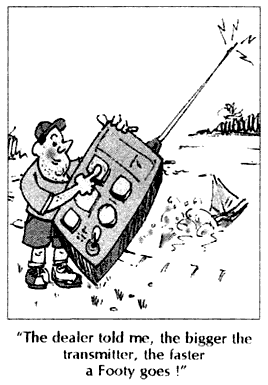 |
| by Mark
Steele - Auckland, New Zealand
Swiss Mini
Sail mastery, `newie’ sailors,
a mighty fine square rigger and those
Kiwi cat-rigged Fiji schooners!
|
A visit to the Swiss
Mini Sail website is a journey of
sheer delight in that it provides a wonderful array
of photographs of often incredibly detailed and authentic
sailing scale models, but be prepared to give yourself
time to browse leisurely rather than hustle through
it. The photograph above shows a group of their delightful
models being sailed at Egelsee, a small lake on the
east side of Berne during a Swiss Mini Sail regatta.
My contact, Stefan Streit who lives in Berne, has
been most cooperative. He is a modeller himself very
active in the Swiss Mini Sail movement and
he kindly supplied me last year with much additional
photographic material, including all of these images
above and below.
The Bisquine Pomare, (a French 19th
century Breton fishing boat model) was built by Felix
Wehrli of Zurich who also built the Tapena Tute.
A group of nice looking boats share the water (photograph
at the top of the page) during a Swiss Mini Sail regatta.
Under sail is Unicornio at Egelsee,
a small lake on the east side of Berne (built by the
late Edi Bannwart who also built the 1900’s
schooner, Andromeda). The photograph (lower
centre) shows a model of a catboat built and sailed
by the father of Stefan Streit.
People(ing) the models!
It’s always going to be a matter of personal
choice of course, whether or not that sailing scale
model is going to carry crew figures or even just
a helmsman (or helmswoman) as Roy Lake of Auckland
carved out of balsa for his Spidsgatter (Danish for
double-ender) Lola. Choose not to include
figures and that’s fine but here are a few examples
where models do carry figures that vary in construction,
both material used and method by various modelers
including Hans Staal of the Netherlands (top right
and bottom left photos below).
|

|
|
|
Starting life as a paddle steamer called Punjab
in 1830 she was bought by the brothers Willis who
added 90’ to her length, removed her boilers
and taking lines off the Cutty Sark converted
her into a Clipper ship called Tweed. She
was to sail seventeen times from Britain to New Zealand
transporting immigrants, one of them (in 1874) being
New Zealander Warwick Stephens Great Grandfather,
a John Millow. Warwick Stephens who lives in the Southern
city of Christchurch in New Zealand has built a lovely
RC model of the vessel which he started in 2004 and
completed two years later.
Six feet in length, the hull fully planked in cedar,
the mats out of southland beach and sails of Egyptian
cotton bought by Warwick and wife Judith in Egypt
the year he started the project. The 1/48th
scale model is fully controlled by radio, has no false
keel and is transported fully rigged. The real vessel
used to return to England after each voyage ballasted
with wool and tea, and Warwick has ballasted the model
with scale wool bales made out of lead placed in the
hull which has 6” of depth of hold and a 10”
beam, the ballast weight accounting for 13.5kg.. The
model is seen in the first photograph on the water
at Lyttelton harbour , the second photograph shows
the builder and his wife with the completed model.
Sailing Rules or is it etiquette?
Some model sailboat(ers), particularly those who
have spent years producing an absolute masterpiece
of a model, understandably tend to be wary of sailing
on the same pond at the same time as `newies’
because of their concern about collisions and resulting
damage. Without wanting my fellow windlers or cruising-minded
model yachties to go the way of the International
Class(es) guys who revel in racing rules ad infinitum,
the best advice I’ve had (from my friend, Des
Townson, fullsize yacht builder, Champion yacht racer,
and maker of the Townson `Electron’ model yachts),
can be summed up in one statement….`sail like
a gentleman! The port tack boat gives way to the starboard
tack boat, the windward boat gives way to the leeward
boat, and knowing that and understanding it, and for
the inexperienced, keeping well clear on the pond
or lake of such `super duper’ models is all
that you need to know. For those who sail those time-consuming
built models, they should remember that they too were
once `rule `green’ and that accidents can happen
! My advice to them would be… play safe and
.sail with guys who sail similar boats or choose a
quiet place or day to sail when there are few boats
(or none at all) on the water. It is sure nice to
see and to sail with fifteen other model yachts on
the water, but that does increase the likelihood of
a `crash-bang’ occurring. One does not have
to be Einstein to work that out!
KEEP YOUR EYES ON
YOUR BOAT!
SCAN LEFT AND RIGHT AND LOOK
OUT FOR OTHER BOATS!
A round the world She Biscuit attempt!
Imagination and humour are two important attributes
to the true windler, so here is the 12 inch long,
She Biscuit, balsa-built by Auckland `Ancient
Mariner’, Bob Walters (seen on his knees below).
There will be three crew on the planned 2007 `round
the world’ attempt, the lady owner at the helm,
and her husband seen in front of the mast. Three did
you say???. Yes Bob who is going to swim alongside
and operate the radio transmitter! (Note the smaller
`squall rig’ for getting around Cape Horn).
I shall keep you posted but somehow I think that
Harley in his Sea Biscuit has a better chance
of a successful rounding than Bob! (He will certainly
get further as Bob admits to not being a good swimmer
and can only dog paddle! He’s practicing though
and is getting the action right and says he is not
going to bother the US Coastguard either! We need
a lot of humour in this world, and must not take ourselves
too seriously!
The Fiji Magic
model schooners were never intended
to set the world alight when they came on the scene
in New Zealand. A few months later with the first
three boats on the water they were hot news. Designed
and built by noted fullsize boat designer, John Spencer,
and taken on board by yours truly who was heading
the Fiji Government’s National Tourist Office
in New Zealand, a further development was agreement
by Marine Modelling International magazine
to produce a workable and professional plan for sale
on it’s (Traplet) shipmodelling Plans Service.
|
|
| 
|
A metre on the waterline, the prototypes, three that
included my own Fijipsy Jack were launched
(shown above) off Russell in New Zealand’s Bay
of Islands. Cat-rigged with easily slipped-on unstayed masts, another was built in Victoria, Australia by Barry Gibson (seen above), one in Japan and another ten or fifteen materialised in various parts of New Zealand. Despite an excellent plan done in England,
and a UK prototype, plus the easy availability of
the plan from Traplet (which is still available),
UK demand was not particularly wonderful, partly I
believe due to the fact that it was cat-rigged as
opposed to a conventional rig, and I don’t think
that the English are particularly keen on rigs of
that sort. It was also flat-decked like normal racing
one metre boats, thus lacking on deck scale or semi-scale
interest. Easily rectified that, (as indeed I did
with Fijipsy Jack) but I don’t think
many considered deck addition detail worthwhile. The
schooners represent a boat of great character, sail extremely well, `goosewing' downwind impressively and as a model were certainly I believe ahead of their time. I still believe that they will one
day enjoy a renaissance of interest and be the subject
of some demand.
Finally friends, let me dispel the theory that the
larger the transmitter the faster your sailboat model
will travel. I have tried it and it just is not true! But then you knew that didn't you?


Previous Columns by Mark Steele:
Articles by Mark Steele:

|